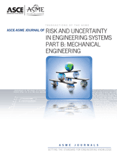
ASCE-ASME Journal of Risk and Uncertainty in Engineering Systems Part B-Mechanical Engineering
Scope & Guideline
Advancing Safety Through Rigorous Risk Analysis
Introduction
Aims and Scopes
- Risk Assessment and Management:
The journal emphasizes methodologies for assessing and managing risks in engineering systems, including probabilistic risk assessment and reliability analysis. - Uncertainty Quantification:
It explores techniques for quantifying uncertainties in engineering processes, aiming to improve the robustness and reliability of engineering designs and operations. - Advanced Computational Techniques:
Research utilizing advanced computational models, such as machine learning and digital twins, to predict and enhance system performance under uncertainty. - Safety and Reliability Engineering:
Focuses on improving safety and reliability in engineering applications through innovative design and analysis techniques. - Resilience in Engineering Systems:
Examines the resilience of systems against disruptions, including natural disasters and operational failures, and methods to enhance system resilience. - Application of Digital Twins:
Investigates the integration of digital twins in engineering practices for real-time monitoring and predictive maintenance.
Trending and Emerging
- Machine Learning and AI in Risk Management:
The use of machine learning and artificial intelligence for predictive maintenance, fault detection, and risk assessment is gaining traction, reflecting the industry's move towards data-driven decision-making. - Digital Twins in Engineering:
The application of digital twin technology for real-time monitoring and predictive analytics is emerging as a significant theme, indicating a trend towards more integrated and resilient engineering systems. - Climate Resilience Engineering:
Research focusing on the resilience of engineering systems in the face of climate change and environmental uncertainties is increasingly prominent, addressing urgent global challenges. - Advanced Uncertainty Quantification Techniques:
There is a growing emphasis on sophisticated uncertainty quantification methods, including hybrid approaches that integrate probabilistic and non-probabilistic models. - Interdisciplinary Approaches to Risk and Resilience:
Collaborative research that combines insights from various engineering disciplines to tackle complex risk and resilience issues is on the rise, reflecting a holistic view of engineering challenges.
Declining or Waning
- Traditional Reliability Analysis Methods:
There has been a noticeable decrease in papers focusing solely on traditional reliability analysis methods without incorporating modern approaches such as machine learning or digital twins. - Static Risk Assessments:
Research dedicated to static risk assessments is declining, as there is a growing preference for dynamic and adaptive methodologies that can respond to real-time data. - Generalized Engineering Applications:
Papers that apply generalized engineering principles without specific focus on risk and uncertainty management are becoming less common, as the journal shifts towards more specialized studies. - Single-Domain Studies:
The journal is moving away from single-domain studies, favoring interdisciplinary approaches that incorporate multiple fields of engineering and technology.
Similar Journals
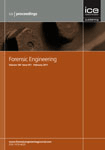
Proceedings of the Institution of Civil Engineers-Forensic Engineering
Pioneering Research for Safer Civil Engineering PracticesProceedings of the Institution of Civil Engineers - Forensic Engineering is a pivotal journal in the field of forensic engineering, published by Emerald Group Publishing Ltd, a renowned name in academic publishing. With a focus on investigating and understanding the failures of civil engineering structures, this journal provides a critical platform for the dissemination of research and case studies aimed at enhancing safety, risk, and reliability in engineering practices. It holds an important place in the Q4 quartile of the Safety, Risk, Reliability and Quality category as of 2023, and currently ranks #123 out of 207 in its field according to Scopus, reflecting its emerging influence despite its relatively recent establishment in 2011. Researchers, practitioners, and students alike will find valuable insights through non-open access articles that contribute to a deeper understanding of forensic analysis in civil engineering contexts. The journal's mission is to promote discussions that lead to significant advancements in civil engineering safety and reliability, ultimately informing best practices and policy-making in the profession.

QUALITY AND RELIABILITY ENGINEERING INTERNATIONAL
Uncovering the Essentials of Quality and Reliability EngineeringQUALITY AND RELIABILITY ENGINEERING INTERNATIONAL is a prestigious journal published by WILEY, dedicated to advancing the fields of quality, reliability, and engineering. With an ISSN of 0748-8017 and an E-ISSN of 1099-1638, this journal provides a platform for scholarly articles that delve into the intricacies of management science, operations research, safety, risk, reliability, and quality, as evidenced by its strong ranking in the Q2 category for both Management Science and Operations Research, as well as Safety, Risk, Reliability, and Quality. Established in 1985 and continuing through 2024, the journal has garnered a solid reputation in the academic community, achieving a Scopus ranking in the 70th and 64th percentiles for its respective categories. Although it does not offer open access, its authoritative content is essential for researchers, professionals, and students seeking to deepen their understanding of quality and reliability principles. With its UK-based publishing address ensuring global reach, this journal remains at the forefront of discussions surrounding engineering quality and reliability methodologies.
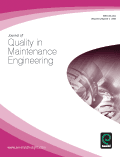
Journal of Quality in Maintenance Engineering
Fostering Knowledge for a Sustainable Future in MaintenanceJournal of Quality in Maintenance Engineering, published by EMERALD GROUP PUBLISHING LTD, is a leading academic journal in the fields of Industrial and Manufacturing Engineering, Safety, Risk, Reliability and Quality, and Strategy and Management. With an ISSN of 1355-2511 and an E-ISSN of 1758-7832, this quarterly publication has been a vital resource for professionals and researchers alike since its inception in 1995. As of 2023, the journal has achieved a commendable Q2 ranking across multiple categories, showcasing its robust influence in advancing knowledge and practices in maintenance engineering. Although not an open-access journal, it offers various access options to facilitate research dissemination. With a focus on quality improvement and sustainable practices in maintenance strategies, the journal seeks to bridge the gap between theoretical research and real-world applications, making it an essential read for anyone invested in enhancing maintenance engineering practices.

STRUCTURAL SAFETY
Innovating reliability for resilient structures.STRUCTURAL SAFETY is a premier journal dedicated to advancing the field of engineering with a focus on safety, risk, reliability, and quality in structural analysis and design. Published by Elsevier, this esteemed journal boasts an impressive Impact Factor and ranks in the top quartiles (Q1) of key categories including Building and Construction, Civil and Structural Engineering, and Safety, Risk, Reliability, and Quality. With a significant history spanning from 1982 to 2024, STRUCTURAL SAFETY fosters scholarly exchange among researchers, professionals, and students by publishing innovative and high-quality research articles that contribute to the safety and resilience of engineered structures. The journal operates without open access barriers, ensuring a broad audience can access invaluable insights in the engineering realm. Its distinguished Scopus rankings further underscore its impactful role within the academic community, making it an essential resource for anyone invested in the discipline of structural safety.

Eksploatacja i Niezawodnosc-Maintenance and Reliability
Advancing knowledge in maintenance and reliability.Eksploatacja i Niezawodnosc-Maintenance and Reliability, published by the POLISH MAINTENANCE SOC, stands as a premier Open Access journal dedicated to the fields of industrial and manufacturing engineering as well as safety, risk, reliability, and quality. With its ISSN 1507-2711, the journal has been a pivotal resource since 2004, fostering knowledge dissemination and innovation within the engineering community. The journal boasts an impressive standing, reflected in its Q2 Quartile ranking in both relevant categories for 2023, and Scopus ranks indicating its significant impact in the domains it covers; specifically, it is positioned at the 50th rank in Safety, Risk, Reliability and Quality and 97th in Industrial and Manufacturing Engineering. Researchers and professionals exploring the intricacies and advancements in maintenance and reliability will find an array of pertinent studies, insights, and methodologies within its publications. Embracing an open access model, this journal not only enhances visibility and accessibility of research but also supports the vital exchange of ideas in the global engineering landscape.

ACCREDITATION AND QUALITY ASSURANCE
Driving Excellence through Rigorous Research.ACCREDITATION AND QUALITY ASSURANCE is a distinguished academic journal published by Springer, focusing on the pivotal intersections of quality assurance, accreditation, and their implications across various disciplines including Chemical Engineering, Chemistry, Instrumentation, and Safety, Risk, Reliability, and Quality. With its ISSN 0949-1775 and E-ISSN 1432-0517, this journal serves as a crucial platform for researchers, professionals, and students aiming to contribute to the enhancement of quality standards in these fields. Since its inception in 1996, the journal has maintained a consistent commitment to disseminating high-quality research, achieving a Category Quartile ranking of Q3 across multiple relevant categories in 2023, reflecting its ongoing impact and relevance in the academic community. While not currently following an open access model, it remains an essential resource for those seeking to stay abreast of the latest developments and research in accreditation and quality assurance practices. With a publication horizon extending towards 2024, ACCREDITATION AND QUALITY ASSURANCE continues to foster scholarly dialogue essential for driving advancements in quality management and global standards.

Journal of Aerospace Information Systems
Unveiling the Next Generation of Aerospace Information SystemsJournal of Aerospace Information Systems, published by the American Institute of Aeronautics and Astronautics, is a premier scholarly platform dedicated to advancing the interdisciplinary field of aerospace information systems. With a focus on innovative research and practical applications, this journal supports the dynamic integration of aerospace engineering, computer science, and electrical engineering. Positioned in Q2 quartiles for 2023 in its respective categories, it ranks notably in Aerospace Engineering (#52/153) and Electrical and Electronic Engineering (#357/797), indicating its significant influence within the scientific community. Research published within its pages addresses a diverse range of technological advancements and applications that are vital for the development of contemporary aerospace systems. As an open-access journal, it facilitates broader dissemination of knowledge, allowing researchers, professionals, and students to engage with cutting-edge discoveries and methodologies. With its competitive impact and commitment to fostering innovation, the Journal of Aerospace Information Systems is an essential resource for anyone involved in the burgeoning field of aerospace technology.
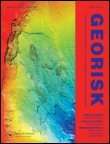
Georisk-Assessment and Management of Risk for Engineered Systems and Geohazards
Navigating the Nexus of Risk and Engineering ExcellenceGeorisk - Assessment and Management of Risk for Engineered Systems and Geohazards is a premier journal published by Taylor & Francis Ltd, focusing on the interdisciplinary fields of building and construction, civil and structural engineering, geology, and geotechnical engineering. With a commendable impact within the scholarly community, it holds a distinguished Q1 ranking across multiple categories, reflecting its relevance and quality. The journal addresses critical issues related to risk assessment and management, especially concerning engineered systems and geohazards, making it an invaluable resource for researchers, professionals, and students dedicated to safety, risk, reliability, and quality. Operating under rigorous peer-review standards, it offers insights and innovative methodologies that empower stakeholders in making informed decisions. The journal is accessible via subscription, providing a wealth of knowledge from 2007 to 2024. Engaging with Georisk ensures that readers remain at the forefront of research and practical solutions in managing risks associated with complex engineering challenges and geological threats.
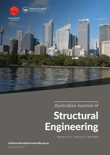
Australian Journal of Structural Engineering
Pioneering Research in Civil and Structural EngineeringThe Australian Journal of Structural Engineering (ISSN: 1328-7982, E-ISSN: 2204-2261), published by TAYLOR & FRANCIS AS, serves as a pivotal platform for disseminating high-quality research in the fields of civil and structural engineering, mechanical engineering, and mechanics of materials. With a publications timeline from 2008 to 2024, this journal plays a crucial role in advancing knowledge and practice within its disciplines, boasting Q3 rankings across various categories as of 2023. Although it operates under a subscription model, the journal remains accessible to a diverse audience, including researchers, professionals, and students, seeking to enrich their understanding and engagement with contemporary engineering challenges. The Australian Journal of Structural Engineering is not only a repository of innovative ideas but also a vital resource for fostering collaboration and sparking discussion among scholars and practitioners striving for excellence in engineering design and analysis.

Ingegneria Sismica
Pioneering knowledge in geotechnical engineering and seismic resilience.Ingegneria Sismica, a premier journal published by PATRON EDITORE S R L, serves as an essential platform for the dissemination of research in the fields of building and construction, geotechnical engineering, and safety risk management. With a focus on earthquake engineering and structural safety, the journal has established itself as a prominent source of knowledge since its inception in 2010. The journal holds an impressive Q2 classification in multiple categories, including Building and Construction and Geotechnical Engineering, reflecting its significant impact within these disciplines. Despite its Italian roots, it appeals to an international audience of researchers, professionals, and students dedicated to advancing the understanding of seismic resilience and risk mitigation strategies. Although open access is not currently available, the potential for knowledge sharing and innovative methodologies presented in the articles continues to attract a robust readership. With its commitment to excellence and relevance, Ingegneria Sismica is poised to shape future discourse in engineering practices aimed at enhancing safety, reliability, and quality within seismic zones.